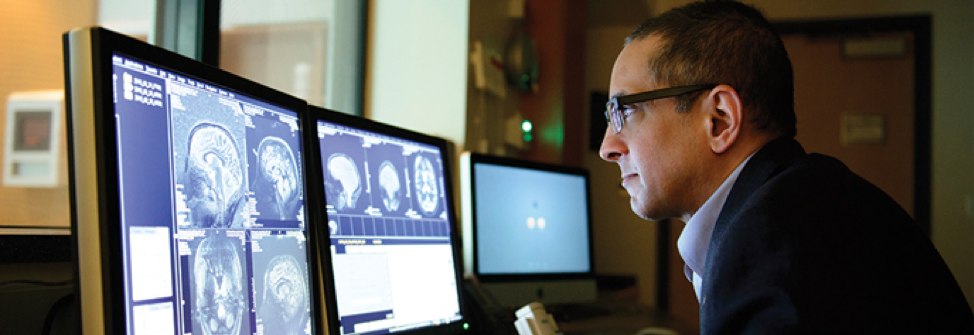Continuing To Lead In Cutting-Edge Research
July 26, 2016 - Crystal Mackay

When the Centre for Functional and Metabolic Mapping (CFMM) first opened its doors at Robarts Research Institute in 1996 you could stand beside the building and see the reflection of the hospital on one side and the University on the other. At the time, it was a revolutionary move; to have a cutting-edge Magnetic Resonance Imaging (MRI) research facility on the doorstep of patient care and academics.
“You need a facility with access to patients and doctors if you want to have clinical impact, and you need access to the academic side to answer the basic science questions,” said Ravi Menon, PhD, Professor at Schulich Medicine & Dentistry and the director and founder of the CFMM. “We are right in the middle of that, we are a bridge between the hospital and the university.”
Menon was recruited in 1994 from the University of Minnesota to establish the high-field imaging facility at Robarts with the aim of helping to answer some of the world’s most pressing medical questions.
During the past two decades, clinicians and researchers at Robarts have been using Functional Magnetic Resonance Imaging (fMRI) at CFMM to see high-resolution images of both anatomical structures inside the brain, but also metabolic features like blood-flow and pH. The technology has been used to explore the basis of diseases like Alzheimer’s, Parkinson’s and multiple sclerosis, and has provided a unique look into what exactly is happening inside the minds of patients in a vegetative state.
In the spring of 1996, when fMRI was just starting to make its mark in the field of imaging, the first MRI system was delivered to Robarts. It was a 4 Tesla (4T), and at the time it was the highest magnetic field in Canada. “In the early days it was unique across the world,” said Joe Gati, PhD, who was hired by Menon in 1996 as CFMM’s Associate Director. “We garnered attention from a lot of other sites for not only our cutting-edge technology but the design and function of the facility. We led the way in a lot of aspects.”
Some of the early work at CFMM involved proving the viability of the technology and demonstrating how improving field strength could exponentially improve image quality. One of the first publications showed the benefits of using 4T MRI. “That paper really propelled the growth of high-field scanners,” said Menon. “At the time we were only the fourth scanner in the world at that field strength and now there are more than 4,000 worldwide.”
This spring, as CFMM celebrates its 20th birthday, the facility continues to be on the leading-edge under Menon’s direction with a dedicated core staff of 14. In the time that he has been director of CFMM, he has watched the field of high-field imaging grow in unimaginable ways.
Currently inside the $35 million CFMM are Canada’s only large-bore 9.4 Tesla MRI for studying animal models of disease, Canada’s only 7 Tesla human MRI and Canada’s first 64-channel 3 Tesla MRI. That represents an increase in the strength of the scanners by almost 100-fold since Menon began his research more than two decades ago.
“With MRI, there is a combination of image processing, and image acquisition, and engineering. It’s just such a growing, innovative, seemingly limitless field for opportunity,” he said.
Part of CFMM’s mission is to advance the field of imaging through innovations in the technology, namely radio frequency coils. Like the lens of a camera, technology can be built for the scanners to focus down on specific areas with more detail for different applications.
“It’s absolutely amazing what we can see now,” he said. “When I go to the scanner here and look at something that we’ve built from scratch and see how it works, it’s pretty incredible.”
While the structure of an organ is important, Menon and his colleagues at CFMM are spending much of their time these days focusing in on the functional information, exploring new imaging techniques that show exactly what those structures are doing. They are trying to answer questions about blood flow, tissue viability, oxygenation, pH and brain activity.
Menon says while there are thousands of labs around the world using functional MRI, there are only half a dozen or so concerned with advancing the technology and exploring exactly how it works.
“What’s next is to be able to measure the electrical activity in the brain directly with MRI instead of going through the intermediate step of looking at blood flow,” said Menon. “To be able to do that would be phenomenal.”
Timeline:
Spring 1996 – Establishment of Western’s Centre for Functional and Metabolic Mapping, and the first 4T MRI is delivered to Robarts
September 1996 – The official opening of the A.M. Cuddy Wing which houses CFMM
June 1999 – First major clinical finding comes out of CFMM showing that the mere threat of an injury can get the brain so worked up that you feel pain even if you aren’t injured.
2005 – Facility undergoes first major renovation for the addition of Canada’s only large-bore 9.4T scanner
2007 – The 4T is decommissioned to make way for the 3T and Canada’s first 7T human MRI scanner
2014 – $7 million in upgrades to 3T and 7T MRIs to improve software and imaging speed





